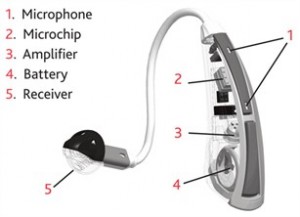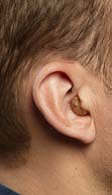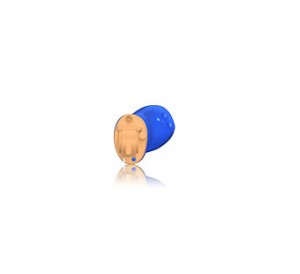

Hearing Aids
A Hearing Aid is a device which is designed to amplify sound for the wearer, with the main focus on making speech more intelligible, whilst reducing or eliminating background noise. They are available in many different styles, sizes and colours and your hearing loss together with your communicative needs and budget, will determine which aid is most suitable for YOU (Scroll down for pictures of Hearing Aids).
How do Hearing Aids work?
Today’s advanced instruments are small and enhance sounds so you can hear much better. While there are many different types and levels of powerful sound processing technologies, five basic components are common to them all:
- Microphones that pick up sound.

- An amplifier that makes it louder.
- A loudspeaker (receiver) that sends amplified sound into the ear.
- An ultra-small chip that processes the sound to fit your hearing needs.
- A tiny battery that runs the sound processors.
Types of hearing aids
1. Behind The Ear (BTE)
Over time, BTEs have become smaller and more elegant. They come in various sizes, the small-est being the Mini BTE. The electronics are housed in a case behind the ear, and the sound is sent through a tube into a custom earpiece that is tailor-made to fit perfectly. 
BTEs come in a variety of colours including neutral colours to match your hair or skin tone.
The larger ones can accommodate a larger battery and amplifier, making them perfect for children and adults who need a more powerful instrument.
2. Receiver in the Ear (RITE) / Open Fit Hearing Aid
Suitable for all kinds of hearing loss, RITE has become the most popular style of hearing instrument. It is lightweight, very small and nearly invisible – a major bonus. And the colours, which range from subtle to bold and trendy makes these solutions very cosmetically appealing. 
This style is also easy on the ear, for two reasons:
- The sound travels in a less noticeable, ultra-thin sound wire straight into a receiver sitting inside your ear, which means even clearer and more natural sound quality.
- The earpiece has a better fit and does not totally block your ear, so it is more comfortable and easy to wear.
3. Custom Made Hearing Aids
Custom hearing instruments are individually tailored to fit the contours of YOUR ear. Whether these are suitable for you will depend on your hearing loss and the size of your ear canal. Crafted in skin-tone colours, these instruments come in various sizes.
In-the-Ear (ITE), In-the-Canal (ITC), Completely-in-the-Canal (CIC) and Invisibly-in-the-Canal (IIC) styles are useful if you want one piece per ear only. Some people doing sports find them more practical. Functionality wise they can be rather limited compared to Receiver-in-the-Ear (RITE) and Behind-the-Ear (BTE) instruments due to lack of space in the ear.
- In-the-Ear (ITE). All of the components are housed in a shell that sits snugly in the visible part of your ear, so there are no wires to contend with. ITEs are easier to insert than smaller, In-the-Canal instruments, and the larger battery makes them suitable even for moderately severe hearing losses.
- In-the-Canal (ITC) & Completely-in-the-Canal (CIC). These sit in the ear canal, making them virtually invisible. Performance-wise, they suit mild to moderate hearing losses, but the very small battery compartments and controls make them unsuitable for anyone with arthritis or manual dexterity problems.
- Invisible-in-the-Canal (IIC). These sit far down in ones ear canal. A very precise impression of your ear needs to made and there is a strict candidacy for such an aid as it depends on the size and shape of your ear canal. Since it sits very far in the canal and is extremely small (100% invisible), the functionality is very limited and there is no option for push buttons or controls. The other aids mentioned above all have space for user controls, i.e. push buttons to change volume and programs.
In-The-Ear (ITE) In-The-Canal (ITC) Completely-in-the-Canal (CIC)



Wireless Capabilities
With today’s latest technology, all of the aids described above can be controlled wirelessly. This wireless technology works seamlessly with hearing aids to enhance positive listening and communication experiences, such as streaming conversation from mobile or landline phones, enjoying one to one communication, watching TV, listening to music, skyping and more. If you have an Android or iPhone, you too can download an App which allows you to control your hearing aids whilst remaining very discreet. See more here: Wireless devices for your hearing aids
Cost of hearing aids
The cost of hearing aids depends on the level of technology that you want to go for. Hearing aids are generally available at a basic level, entry level, mid level and top level. The higher the level of technology you go for, the better it will function or adapt in challenging listening environments. There are options available for all ages and all budgets! This is something that you can discuss with your audiologist via telephone, email or at the consultation. Most medical aids provide benefits or contribute a portion towards hearing aids. This all depends on the medical aid and the plan that you are on.
There are various Hearing Aid Companies from which you and I can select the most appropriate hearing aid. These are namely: Oticon, Widex, Unitron, Siemens, Beltone and more. You will have the opportunity to trial hearing aids from the preferred company, in order to make sure that the best one has been selected for you.
Here are a few examples of what hearing aids look like today. You may click on the heading which will direct you to their website:
Oticon





Widex





Siemens
Unitron











